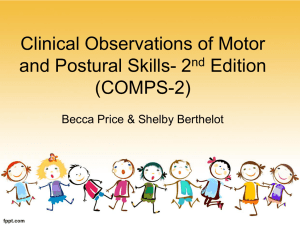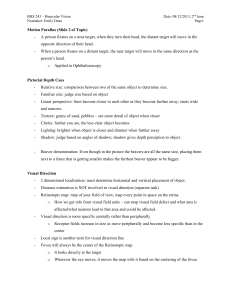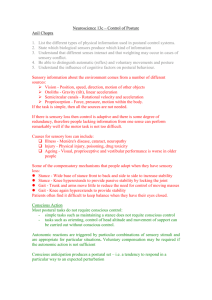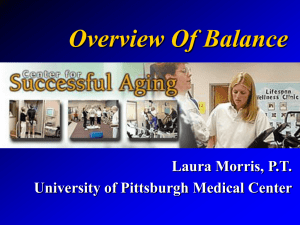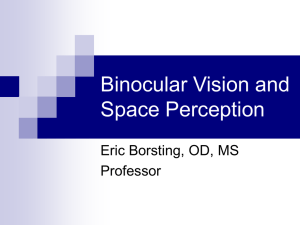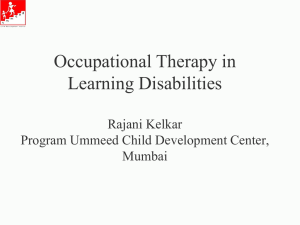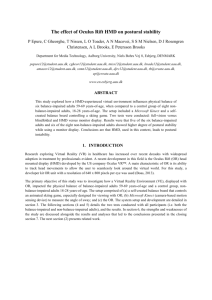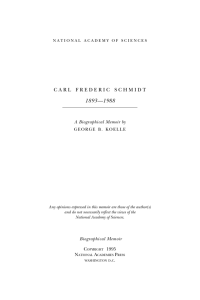Click on Link for Lab Notes
advertisement
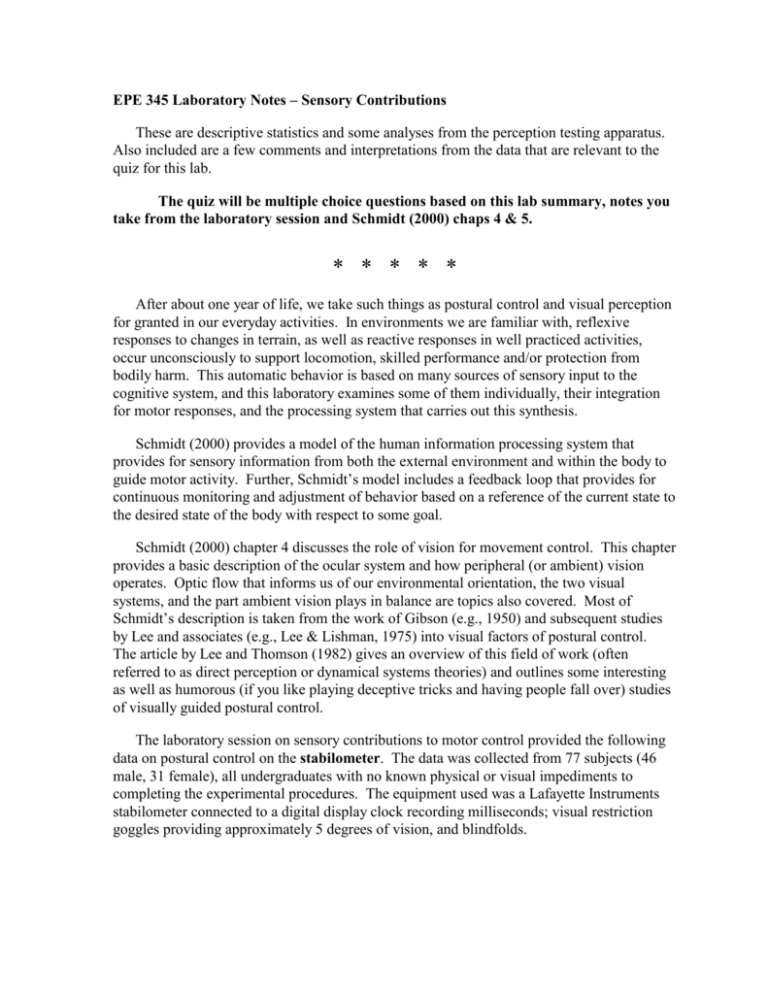
EPE 345 Laboratory Notes – Sensory Contributions These are descriptive statistics and some analyses from the perception testing apparatus. Also included are a few comments and interpretations from the data that are relevant to the quiz for this lab. The quiz will be multiple choice questions based on this lab summary, notes you take from the laboratory session and Schmidt (2000) chaps 4 & 5. * * * * * After about one year of life, we take such things as postural control and visual perception for granted in our everyday activities. In environments we are familiar with, reflexive responses to changes in terrain, as well as reactive responses in well practiced activities, occur unconsciously to support locomotion, skilled performance and/or protection from bodily harm. This automatic behavior is based on many sources of sensory input to the cognitive system, and this laboratory examines some of them individually, their integration for motor responses, and the processing system that carries out this synthesis. Schmidt (2000) provides a model of the human information processing system that provides for sensory information from both the external environment and within the body to guide motor activity. Further, Schmidt’s model includes a feedback loop that provides for continuous monitoring and adjustment of behavior based on a reference of the current state to the desired state of the body with respect to some goal. Schmidt (2000) chapter 4 discusses the role of vision for movement control. This chapter provides a basic description of the ocular system and how peripheral (or ambient) vision operates. Optic flow that informs us of our environmental orientation, the two visual systems, and the part ambient vision plays in balance are topics also covered. Most of Schmidt’s description is taken from the work of Gibson (e.g., 1950) and subsequent studies by Lee and associates (e.g., Lee & Lishman, 1975) into visual factors of postural control. The article by Lee and Thomson (1982) gives an overview of this field of work (often referred to as direct perception or dynamical systems theories) and outlines some interesting as well as humorous (if you like playing deceptive tricks and having people fall over) studies of visually guided postural control. The laboratory session on sensory contributions to motor control provided the following data on postural control on the stabilometer. The data was collected from 77 subjects (46 male, 31 female), all undergraduates with no known physical or visual impediments to completing the experimental procedures. The equipment used was a Lafayette Instruments stabilometer connected to a digital display clock recording milliseconds; visual restriction goggles providing approximately 5 degrees of vision, and blindfolds. The results for the three conditions of vision are given in Table 1. While it seems obvious there is a trend in the absolute time on balance across three conditions of visual information, we need to make some interpretation of the shape of the data. From Schmidt (2000) we know that ambient vision is a faster feedback loop than focal vision. We would expect, therefore, that the removal of the former will have a greater impact on postural corrections than the latter. The data support this - performance decrement is greater between vision and restricted vision than between restricted vision and no vision. Table 1. Time on balance (stabilometer) for three conditions of vision. Full vision Restricted vision No vision 11.02 8.06 6.88 Mean time on balance (secs) These trends for the variation in visual information are shown in Figure 1 below. Figure 2 is a diagram of the eye showing the location of the receptors for the two fields of vision. Ambient vision is detected on the periphery of the retina (none of the area included in the fovea). This is not particularly rich in receptors relative to the fovea and is mostly used for black and white vision and sub-conscious detection of the environment. The fovea provides a more acute area for vision and is the ‘center of vision’ which is directed to the most attention demanding object in the visual array. This object then becomes the point of focus and convergence of the eyes. Beyond the eye itself, the ambient system sends feedback directly into the motor response area of the cognitive system, providing fast adjustments to motor actions. Focal vision takes a path through an error correction process in the cognitive system. This is therefore slower in developing corrections, and more designed for altering or switching motor programs, and for learning optimum responses for any goal directed activity. Time on Balance (secs) 12 10 8 6 4 2 0 Full vision Partial vision No vision 2 Figure 1. Mean time on balance for three conditions of vision. 3 Figure 2. Section through the eye. Depth perception relies considerably on binocular vision including as much on the musculature of the eye as on information from the light rays. Convergence of the eyes occurs when the eyeballs rotate inwards to fixate the fovea of both eyes on an object. Information from the musculature of the eye provides the sensory input to determine the distance and/or any changes in distance as you fixate the object. Another cue source for distance is monocular and involves changes in the shape of the lens of the eye to accommodate the focusing of light rays onto the retina. As shown in Figures 3 & 4, it is again the muscles pulling or relaxing on the lens that supplies this information. Figure 3. Changes in the lens of the eye for near and distant vision 4 Figure 4. Eye lens structure and accommodation for focusing. Figure 5 shows the error recorded for binocular and monocular vision. It is easy to appreciate the value of binocular vision given these differences. Of course these values are only seen at close proximities when the convergence and accommodation of the eyes is considerable. 70 Error (mm) 60 50 40 30 20 10 0 binocular r. eye l. eye Figure 5. Error scores for various levels of binocular and monocular vision. # of errors The mirror trace requires us to invert our perceptual system and make movements against what our vision is indicating is correct. For most people, the feedback system has no understanding for this incompatible information. That is not to say that it will not adapt, and given enough practice, mirror tracing becomes quite easy. Figure 6 shows the improvement over trials on this ‘skill’. 6 5 4 3 2 1 0 trial 1 trial 2 trial 3 Figure 6. Error scores across trials for mirror tracing. 5
